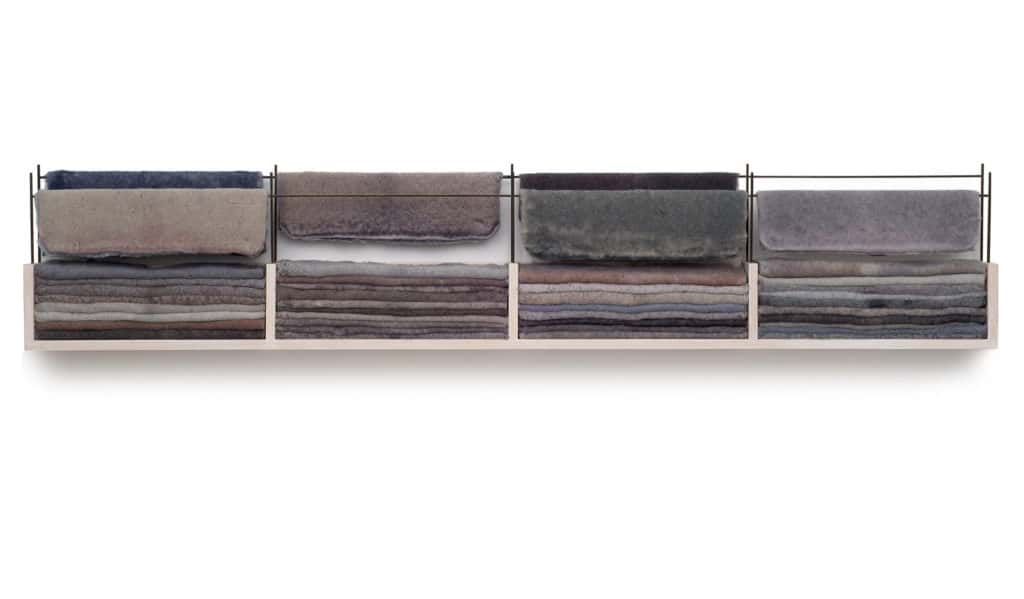The next time you clean out the lint tray in your spin dryer, resist the impulse to wad the lint into a ball and throw it away. Instead, keeping the lint intact, lay it on a flat surface. Repeat this process for about a year until the oblongs come to resemble counterpanes in an eighteenth century orphanage or horse blankets. Now carefully fold them as if they were really were counterpanes or horse blankets. Admire your work and marvel at the striations of color — all the greys and mauves and bluish hues. Think about how many of the acts we perform thoughtlessly, day after day, and to which we ascribe little value, are in themselves art and so too — in the right hands — are the detritus of our works and day, and then you’ll begin to understand the art of Carolyn Conrad. “When I pulled the material from the trap, the fibers looked so beautiful to me,” says Conrad from her studio. “The material was so fragile and delicate, well, I thought it deserved our attention.”
The dryer lint assemblages fit into the larger framework of Conrad’s decades-long inquiry into domestic spaces and the nature of home. Ongoing work in that vein includes her moody images of what appear to be true-to-scale houses in fields. In fact, Conrad constructed, arranged, and photographed every element in the picture, from the 5 x 8 houses that she makes out of clay and laminated balsa or bass wood to the heavy canvas fabric that she dyes and re-dyes in shades of storm-light-grey to approximate the sky. Once assembled on a table in her studio, she photographs the scene and prints it on archival paper.

The wooden house series evolved organically, in the shadow of the terrorist attacks of September 11, 2001. “I felt I needed to make more contact with family,” Conrad recalls, “in a personal way.” And so, tentatively — she wasn’t a skilled photographer at the time — she began to photograph the clay figures, busts, and ordinary objects in her studio. “At first I was just playing around,” she says. “But once I got going, I thought, ‘Goodness, maybe I can do something serious with this.’”
That “something serious” speaks of our vanishing rural landscapes, atomized societies, and increasingly hermetic notions of home. It’s no coincidence that Conrad, who did graduate work in fine arts at New York University, held a day job for over a decade in the communications department of an international architecture firm. Hence, dealing with elevation plans and “very pared down structural forms” are second nature to her.
For all the simplicity of her work, its gestation, Conrad says, is long. “I get excited about a concept or a process, but when I try to execute it, I’m usually disappointed. So the initial failure forces me to go in an unexpected direction. My pieces have a formal quality, they do, but there’s a lot of accident along the way.”










!['The Maples' is a prestigious generational compound of two extraordinary estates: 18 Maple and 22 Maple. This rare offering, designed by luxury architect Lissoni partners New York and developed by visionaries Alessandro Zampedri-CFF Real Estate and JK Living, redefines opulence with the highest quality of craftsmanship and captivating views of the Atlantic Ocean. Represented by @nycsilversurfer and @challahbackgirl of @douglaselliman. [link in bio]](https://hamptonsrealestateshowcase.com/wp-content/uploads/sb-instagram-feed-images/438891010_1083749139481747_7890082604579275354_nfull.jpg)
![Featuring 360-degree water views on Mecox Bay, the Atlantic Ocean and Channel Pond, 1025 Flying Point offers the ultimate beach cottage that is flooded with natural light. With panoramic views, proximity to the ocean, and a private walkway to Mecox bay for kayaking or paddle boarding, this truly is a special retreat. Represented by @ritcheyhowe.realestate and @hollyhodderhamptons of @sothebysrealty. [link in bio]](https://hamptonsrealestateshowcase.com/wp-content/uploads/sb-instagram-feed-images/438994305_737511778456166_4602476013493875279_nfull.jpg)
![Attention advertisers! 📣 Secure your spot in the highly anticipated Memorial Day edition #HRES. Reach thousands of potential clients and showcase your brand in one of the most sought-after publications in the Hamptons, NYC, Palm Beach, and beyond. Contact us now to reserve your ad space! [link in bio]](https://hamptonsrealestateshowcase.com/wp-content/uploads/sb-instagram-feed-images/438549843_275102939023235_6718257301437562124_nfull.jpg)
![You eat with your eyes, and on the East End, it’s important that what you eat looks just as good as how it tastes. At @rosies.amagansett, the restaurant itself is plenty photo-worthy with blue ceramic tiling and yellow and white striped fabric wallpaper. But for a dish that will light up your photos, head directly to the salmon tartare! [link in bio]](https://hamptonsrealestateshowcase.com/wp-content/uploads/sb-instagram-feed-images/437094269_7296727147115953_1594410326824303644_nfull.jpg)

![We were honored to be the media sponsor for @blackmountaincapital's open house event with @jameskpeyton and @jfrangeskos at 11 Dering Lane in East Hampton! Other sponsors included @landrover, Feline Vodka, @rustikcakestudio, @la_parmigiana, @lahaciendamexicangrill11968, @homesteadwindows, Stone Castle, @talobuilders, and @thecorcorangroup.
A big thank you Carrie Brudner of Black Mountain Capital for putting together this fabulous event! [link in bio]](https://hamptonsrealestateshowcase.com/wp-content/uploads/sb-instagram-feed-images/437081213_762912965932136_6847332836522786568_nfull.jpg)

![Blooms Galore at the Long Island Tulip Festival! 🌷✨ Mark your calendars for April 15th as the vibrant tulips at @waterdrinkerlongisland burst into full bloom! Enjoy a day filled with colorful splendor, food trucks, live music, and more. [link in bio]](https://hamptonsrealestateshowcase.com/wp-content/uploads/sb-instagram-feed-images/437083429_974242677583725_6855805712693638343_nfull.jpg)
